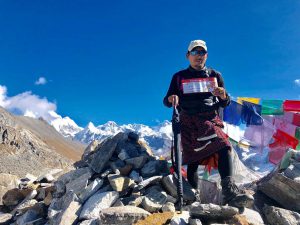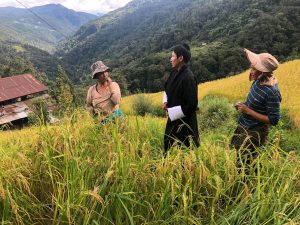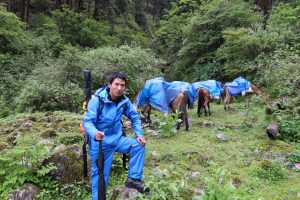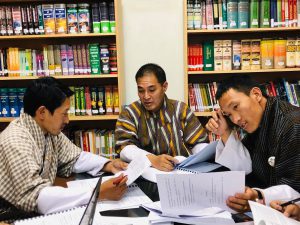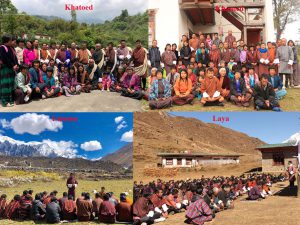Why didn’t I support the Tobacco Control (Amendment) Bill of Bhutan 2021?
- July 5th, 2021
- 3,649 views
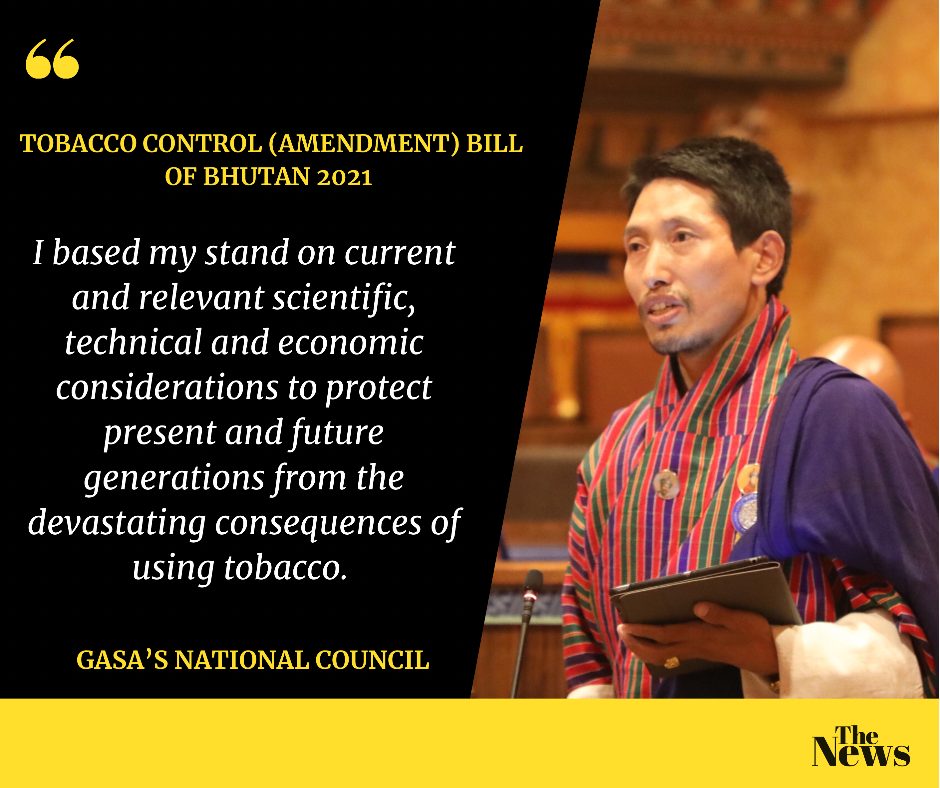
The parliamentarians in the past invested so much time and resources in deliberating the Tobacco Control Acts, but the recent amendment easily sailed through both the Houses of the Parliament without much debate, on the pre-condition that it is an “Urgent Bill.”
However, I could not support the amendment bill.
It was not because I am a superstitious or hypocrite. I based my stand on current and relevant scientific, technical and economic considerations to protect present and future generations from the devastating consequences of using tobacco. I always stand by my principle – the interest of the nation and the people. Furthermore, the Kantianism Theory rightly stated that an action is morally right if it is motivated by the goodwill that stems from a sense of duty.
Legal Framework
Since Bhutan ratified the World Health Organization’s Framework Convention on Tobacco Control (WHO FCTC) on 23rd August 2004, the country prohibited cultivation, harvesting, manufacture, supply, distribution and sale of tobacco products through the enactment of the Tobacco Control Act of Bhutan 2010 (amendment 2012 and 2014) and enactment of the Rules and Regulations 2011 (amendment 2013 and 2015).
The Parliament enacted the Tobacco Control Act in 2010 and deliberated on amendments in six parliament sessions, considering the following points.
- Concerning the physical health and well being of the people of Bhutan, which are important elements of the development principle of Gross National Happiness.
- Recognizing the harmful effects of tobacco consumption and exposure to tobacco smoke from a spiritual and social health perspective.
- Recalling that the National Assembly of Bhutan, during the 82nd session held on 12th August 2004, ratified the WHO Framework Convention on Tobacco Control (FCTC).
- Acknowledging that as a party to the WHO Framework Convention on Tobacco Control, Bhutan is implied by its provisions to implement it through national legislation and policies to fulfil the obligations, and
- To Ensure the effective control of tobacco and tobacco-related products
The banning isn’t a solution nor making tobacco readily available and affordable is a wise decision. The existing legislation ensures non-smoking areas, offences and fines for buying tobacco products, restrictions on advertisement and promotion, and procedures of import for personal consumption.
Health Implications
Tobacco continues to be the leading cause of preventable non-communicable disease, deaths and disability – affecting people in the most productive years. According to a World Health Organization report, the tobacco epidemic is one of the biggest public health threats: more than 8 million people die in a year worldwide. More than 7 million deaths were from direct tobacco use, while around 1.2 million deaths related to second-hand smoke.
WHO Office for Southeast Asia reported that tobacco kills an estimated 221 people each year in Bhutan. Among others, heart disease and stroke are the most common ways people die of tobacco use. Most people start early, increasing the risk of heart disease in younger people – the mean age of initiation stands at 18.9 years.
Therefore, Tobacco control is essential for preventing and controlling deaths and disabilities. More than 120,000 active tobacco users and those exposed to secondhand smoke are at increased risk of cardiovascular diseases.
Tobacco-related mortalities would rise while the average life expectancy of 71.46 would be reduced.
Evidence suggests that the severity of COVID-19 is higher among smokers. The COVID-19 fatalities are higher among people with pre-existing conditions, including non-communicable diseases such as cardiovascular and chronic respiratory conditions, cancer, and diabetes.
Therefore, the recent amendment of the TCA (2021) could also defeat the Ministry of Health’s strategy to gain herd immunity to combat the pandemic.
Economical Implications
Over 80% of tobacco users are in low and middle-income countries, where the burden of tobacco-related illness and death are the heaviest. Tobacco use leads to poverty by diverting household spending from basic needs to tobacco.
Findings from the 5th Global Youth Tobacco Survey revealed that more than one out of five students (22.2%) currently use tobacco products (2019). The prevalence of current cigarette smoking was 14.7%. 12.5% of students currently consume smokeless tobacco products.
Despite the stringent laws, tobacco consumption remained high in Bhutan, and youth start using it at a very young age. The recent amendment of the Tobacco Control Act has exposed an economically productive population (30–69 years) of 3,32 000 (41%) and a youth population (13–17 years) of 73 000 (9%) to the risk associated with tobacco use.
Therefore, the economic costs of tobacco use are substantial and include high health care costs.
Social and culture Implications
The recent amendment of the TCA (2021) will have an impact on individuals, families, and the nation. Research indicates that the poor are the ones who smoke the most. Tobacco worsens poverty among its users. Smoking accounts for much of the mortality gap between rich and poor.
Tobacco use imposes a heavy burden on society and families by – increasing illnesses and deaths – affect the economic situation of tobacco users and their dependents. There is also a threat to the environment.
Tobacco-related diseases kill one-fourth of smokers in the middle of their active life, which will seriously impact family members dependent on their income.
Treatment of tobacco-related illnesses is costly: heavy burden on governments’ finance; high-income countries account for 6-15% of annual healthcare cost.
Loss of productivity due to ill health: smokers have about 50% more sick days than non-smokers, more early retirement, lost working years from premature death.
Smoking has many adverse reproductive and early childhood effects, including an increased risk for infertility, preterm delivery, stillbirth, low birth weight and sudden infant death syndrome (SIDS). Women smokers often have symptoms of menopause about three years earlier than non-smokers.
The government’s recent decision on tobacco, making it freely available in the market is also against the Buddhist doctrine and religiously sensitive to discuss. Let the law of Karma take care of itself.
Will the TCA (Amendment) stop smuggling in the border areas?
The government presented the Tobacco Control (Amendment) Bill saying that tobacco smuggling cases had increased with the imposition of restrictions at the points of entry at the southern borders, and the smuggling caused security risks in the country.
The Southern Covid-19 Task Force had pointed out that tobacco smuggling was the main reason for the spread of Covid-19 in the southern dzongkhags, as presented by the Economic affairs minister. The government believes that tobacco will be readily available at lower prices if the Act is amended, and the smuggling cases will fall. On contrary, the minister also confessed that the Duty-Free Limited had not adequately served all consumers, although Bhutan Duty-Free Limited is one of the State-Owned Enterprises under the Ministry of Finance.
If what the government claim is valid, how about the drugs-related smugglings in the border areas?
A short comparative analysis between the tobacco and drugs smugglings shows equal security risks:
- In 2018 the Royal Bhutan Police (RBP) under Chhukha Dzongkhag registered 158 drug-related cases (TheBhutanese, 01/26/2019).
- Royal Bhutan Police (RBP) registered 192 drugs and tobacco-related cases and arrested 985 people in connection to 192 cases. Moreover, Thimphu police have registered 140 cases and arrested 336 people in connection to drug cases (TheBhutanese, 07/26/2020).
- Regarding tobacco, as per the Office of Attorney General, the number of tobacco-related cases had increased from 16 in 2019 to 42 in 2020 and 14 in the first six months of 2021. Moreover, about 307 cases of tobacco smuggling were recorded between 2020 and 2021.
Considering these facts, unless the government addresses the security risk posed due to drugs smuggling in the border area, the mere amendment of the tobacco control does not serve the intended purpose. However, I am neither recommending the government to legalize the drugs nor support the tobacco control (amendment) bill 2021.
Nevertheless, the amendment’s implications for the future of the nation and people are beyond impairment.
The government had also waived 100 percent tax with the amendment of the Tax Bill of Bhutan 2021, which makes the situation even worse. Tobacco will be readily available and affordable, turning it into everyone’s choice.
WE ARE SETTING HOME ON FIRE JUST TO KILL RATS!
The covid-19 vaccine gives us hope for the future
- January 3rd, 2021
- 1,636 views
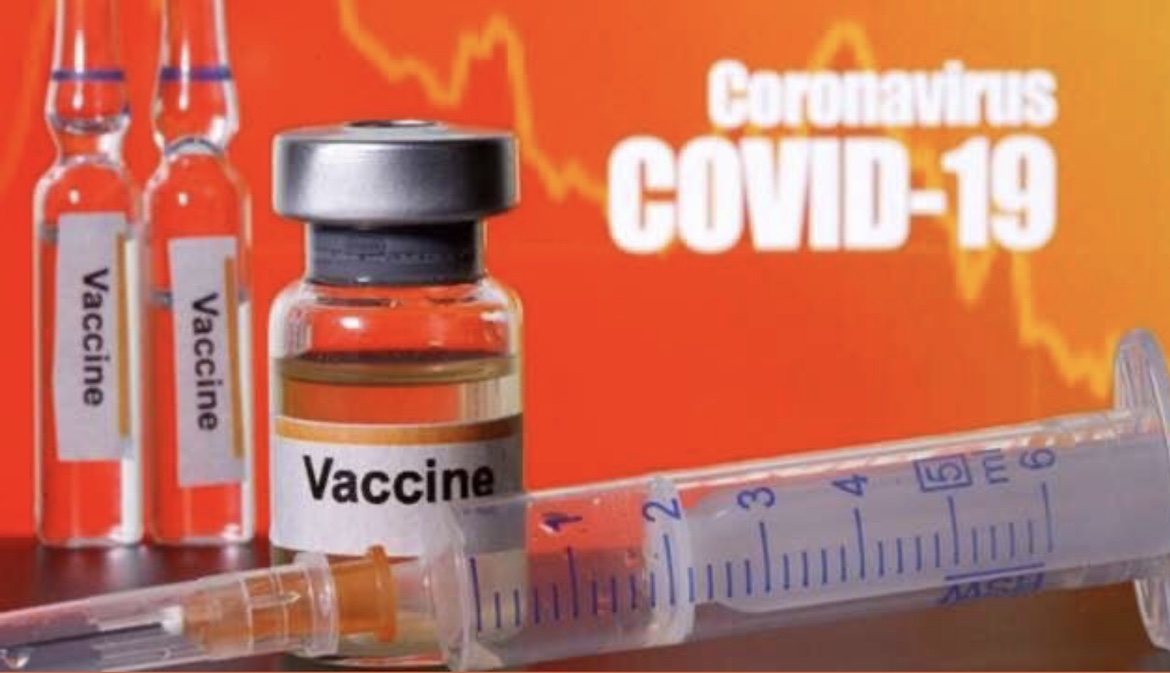
Until an effective vaccine for Covid-19 is ready, effective and well-designed lockdowns with reliable and easily accessible testing methods are the only way forward.
Bhutan experienced nationwide lockdown twice since 11th August last year after a returnee from abroad tested positive outside the quarantine facility. Of late the government enforced the second nationwide lockdown from December 23, 2020, following reports of sporadic cases from flu clinics in Thimphu and Paro. Few cases were also detected in Lhamoizingkha; evidence of local transmission.
However, the recent news of vaccines coming into play gives us hope for the future, only vaccine can end the Covid-19 pandemic. A vaccine for COVID-19 will be a critical tool to bring the pandemic under control, combined with effective testing and preventive measures.
With several promising vaccine candidates in the pipeline, some under review for approval, and the Pfizer/BioNTech and Moderna vaccines approved for use, the race for a safe and effective vaccine has entered a new phase.
There are currently more than 200 vaccine candidates: 56 in clinical and 166 in pre-clinical development. A number of these vaccine candidates are in Phase III clinical trials – the final step before a vaccine is approved.
The two leading vaccine candidates were developed by Moderna Therapeutics, which reported 94.5 percent of efficacy, and Pfizer partnering with the German company BioNTech, showing 95 percent success rate, including 94 percent among those 65 and older.
UNICEF aims to make 2 billion doses of the vaccine available under the COVAX plan by the end of 2021. Under the COVAX plan, the initial doses of vaccines are intended for health workers, social care workers, and people at high risk, such as the elderly or those with underlying conditions.
They are unlikely to be given to children. These populations have been prioritized to help reduce morbidity from COVID-19 and help protect health systems that serve everyone.
Distribution of the Pfizer/BioNTech vaccine is underway in most countries, including the US and UK. India expects to begin vaccinating people against Covid-19 in January this year.
As per the federal health officials of India, around 300 million Indians will be vaccinated between January and early August. It will begin with an estimated 10 million health workers, followed by policemen, soldiers, municipal, and other frontline workers.
India’s drugs regulator today approved Serum Institute’s Oxford’s Covid-19 vaccine Covishield and Bharat Biotech’s Covaxin for restricted emergency use, paving the way for their roll-out soon.
China’s health authorities have approved a Covid-19 vaccine from state-owned Sinopharm for general use on the population and rollout to begin ‘soon’ but about a million have already received injection under emergency approvals.
Bhutan is safe so long as the world is free from Covid-19 and our neighboring giants; India and China are 100% vaccinated and gained herd immunity.
Nevertheless, the Government of Bhutan shared detailed plans to distribute Covid-19 vaccines since September last year. Kuensel reported that the high-risk workers in the healthcare facilities, active front-liners such as police, army personnel, De-Suups, and elderlies above the age of 60 years, and people with comorbidities were considered for the first phase of the distribution.
The second phase is expected to cover passive frontliners – individuals who are in constant contact with the large groups (like media personnel), students, and staff of functional schools and institutions.
Children below 12 years and pregnant women would be included in the third phase while the rest of the population (age 13 to 60 years) residing in the country and who do not fall under any of the above categories would be included in the fourth phase.
As a member of the COVAX facility, Bhutan would receive free vaccines for 20 percent of its population. Meaning, about 150,000 people of the total 756,129 population would be the first recipients of the vaccine.
However, COVAX would deploy the 20 percent in tranches as the first tranche would cover around three percent of the population. The remaining 17 percent would be deployed in the next tranche.
Recently, the Ministry of Health submitted an application to the COVAX facility for vaccine supply, and the first batch of vaccine is expected to dispatch in the first quarter of 2021.
How faster everyone’s lives will return to normal, including society opening and recovery of the economy will depend on the uptake of the vaccine and reach to the herd immunity.
The bottom line is that an effective vaccine will certainly diminish greatly the relative risk of transmission but we still should not completely abandon basic public health measures, including the wearing of masks.
The NA endorsed Supplementary Budget of 5M; it’s purely conflicting and a wrong precedence
- June 23rd, 2020
- 2,411 views
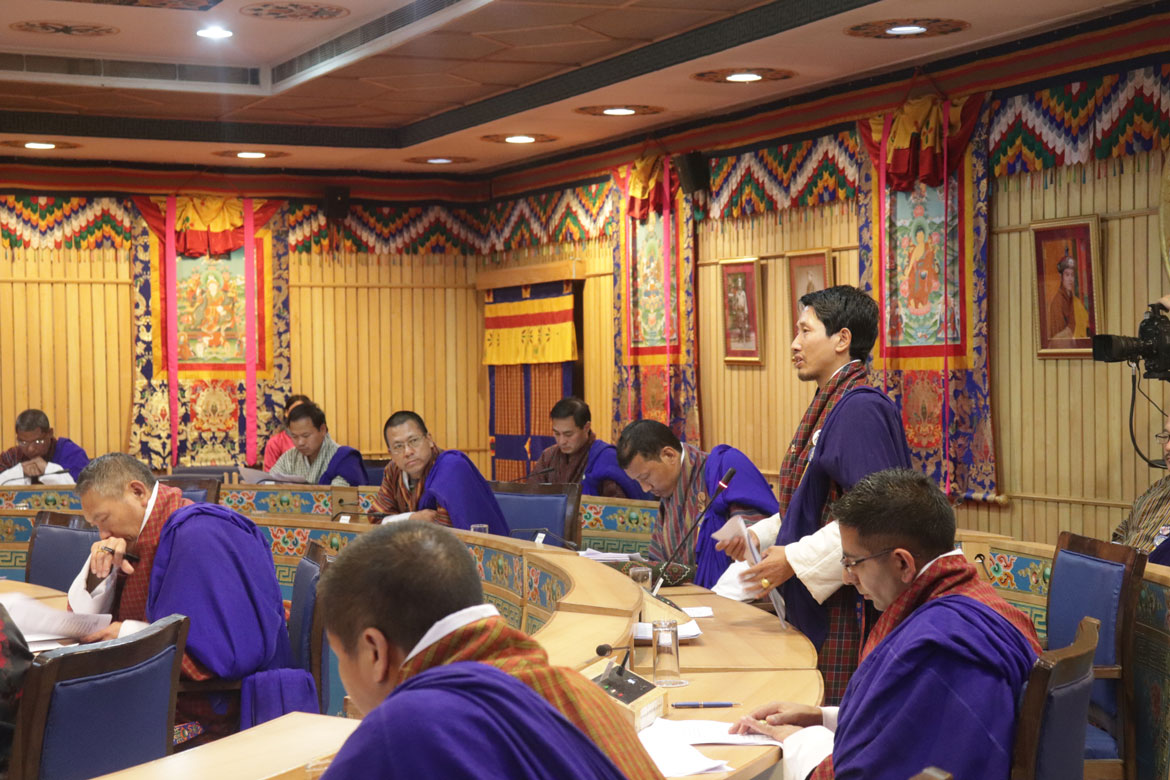
I raised my concerns during the 5th sitting of the 25th session of National Council regarding the supplementary budget appropriation of Nu. 5M, proposed and approved by the National Assembly on 11th February 2020 with 44 Yes votes.
The same budget was presented again in the first week of June, that the National Assembly is returning the amount to the finance ministry. That is just a drama and for publicity to make up with their wrongdoings. The fact is that the Supplementary Budget Appropriation Bill for the Financial year 2019-20 that has been passed before the first case of COVID-19 has never been endorsed for implementation.
Appropriating the supplementary budget for the parliamentary committee and secretariat services came without prior scrutiny from the finance ministry and violated the budget process and the Public Finance Act 2007. Any kind of supplementary budget should root through relevant ministry which is then forwarded to the Finance Ministry for approval.
The other supplementary budget for Royal Bhutan Police (for revised pay and allowances), Khesar Gyelpo University of Medical Sciences (for revised pay and allowances, students stipend), similarly for the Jigme Singye Wangchuck School of Law and State-Owned Enterprise subsidy all came through a proper proceeding.
It was surprising to learn how the most important institution of the nation turned deaf to the National Council’s recommendations.
The precedent was unhealthy for a democracy like ours that undergoes constant evolution with days. The views expressed from NC were a waste of time because they went ahead with the budget and approved it.
My colleagues in the house shared the same concerns; the legitimacy and the conflict of interest of the bill proposed to meet the shortages at the parliamentary committee and secretariat services. Consequently, the House decided to repeal the section with recommendations.
The national council also experienced the same shortage of resources. Do we follow the same trend? Should the future government do the same and keep increasing the supplementary budget appropriation ceiling.
NC members shared appropriating such a supplementary budget to overcome shortage each time would violate existing norms and set the wrong precedent.
We also questioned if the procedure followed to approve the budget was right and whether it was in line with the existing norm. However, the appropriation was approved and later returned as claimed. The way the national assembly approved the budget was unexpected and disrespectful. This also reflects the integrity of the people’s representatives in the august hall.
Our recommendation should have been heard well, especially in times like today where the government’s coffer is taking an unexpected pinch. We should all aspire to listen to one another and work firmly together with integrity.
I wish that the wisdom of the highest legislative body should prevail to abide by the laws and avoid the conflict of interests henceforth.
Reflections of two years in the Parliament of Bhutan
- May 18th, 2020
- 1,199 views
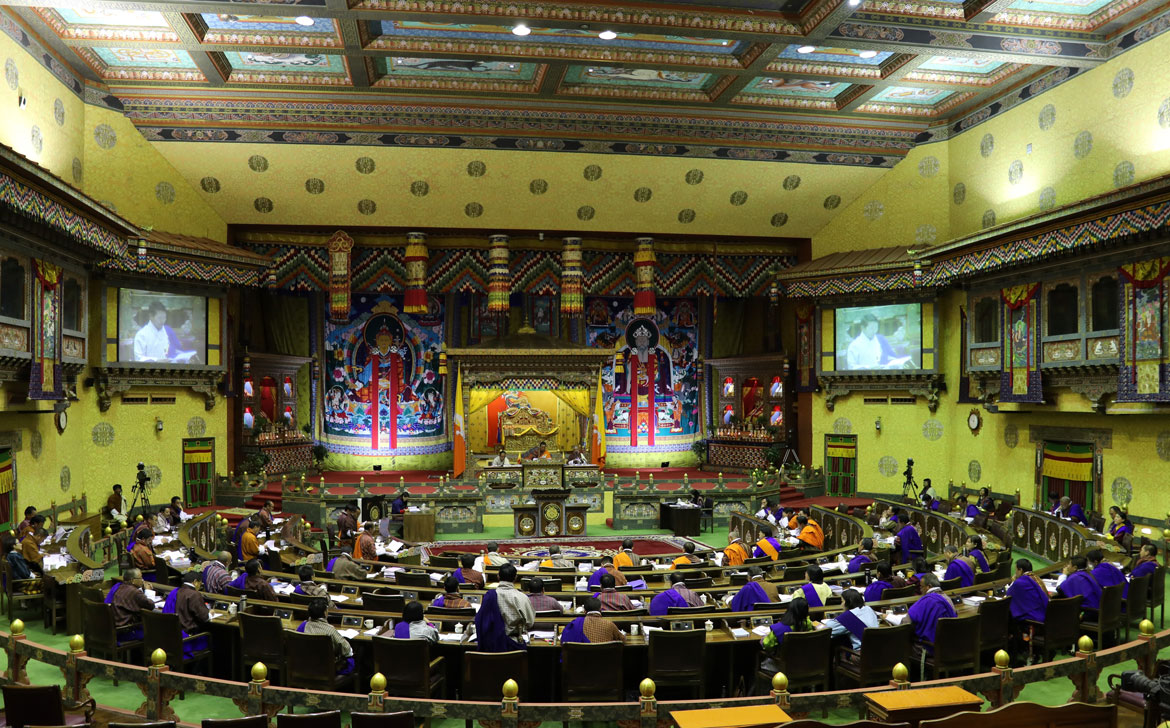
Two years representing the people of Gasa Dzongkhag was a journey that kept me moving closer to the heart of this nation, more than ever. I have come to know more about the community and myself.
The first two years have been overwhelming and adventurous after signing the Oath of Office and pledging to work tirelessly on fulfilling the sacred mandate of the great institution, the great visions of monarchs, and the dreams of the people.
The job of a Member of Parliament is unlike any other profession one would have previously experienced. You are expected to be an advocate, social worker, orator, negotiator, mediator, sociable, social convener, and a lawyer. This versatile need of the profession has questioned and pushed me hard to become a better one always.
I got an opportunity to visit the places located at the highest elevation in the country, enduring the harshest weather because it mattered the most to the people and the country. The experience among glaciers and clouds was awakening. This is the latest moment I cherish as the representative of the people.
One day I was amongst the ranking delegates and officials, the other days I was with the people and youth of my constituency. In attending both functions, I always kept my true colours close to my heart. This kept me talking about my people and the country with almost all the people and in the places I have been to in the past two years. I will continue to let the world hear about my people and the country.
I come from a constituency where people are least aware of our work as their representative. I made sure people understood, the basics of what we were doing in the Parliament. This would go a long way and I am more prepared to shoulder them with the best ability of mine.
Among the communities that are least developed in Bhutan, I started a welfare scheme, a personal initiative that caters to the needs of my constituents today.
The initiative came from my own experience and situation. The struggles and the unfortunate circumstances are uncertain in times like today. I wanted to shoulder my people in a time of bereavement. Today I am happy that this has become a reality.
For the welfare scheme, I surrendered my annual discretionary allowance entitled to the Member of Parliament in the country, the first to do so among the parliamentarians in the country. Positive precedence I feel optimistic about as a young parliamentarian.
In the parliament so far, I have opposed the views shared by the government and supported where it is due. The decision that would impact my people was least welcome and critiqued on behalf of the people.
Despite being a regular and active participant in the committee meetings, and during debates in the Parliament, I made sure that the issue concerning my people on the ground was heard and discussed at all levels.
The journey took me to different parts of the country and also to the parts of the world that helped me realize and learn about the fast-changing world.
My work in parliament also involved representing Bhutan in important international and regional forums like the 19th General Assembly of the APPCED in South Korea in December 2019 and the 140th IPU Assembly meeting in Qatar in April 2019.
I was in India, speaking to the professors and faculty at the Asian College of Journalism in Chennai about my country. Many of them had the experience of working in media for more than a decade. I was also allowed to share my views on the Role of Young Parliamentarians in Regional Cooperation during the 4th Memorial Lecture of the UNESCO Goodwill Ambassador Madanjeet Singh at Pondicherry University in India in April 2019.
Many a time, the experiences and works in the Parliament were unceasing and limitless. However, the needs and expectations of the people kept me moving and made me stronger day by day; turning me into a representative they always saw in me.
As important as it was, working with the parliamentary group was challenging and learning. It was difficult to balance individual views and the concerns of the constituents with the discipline and platform of the parliamentary group that may share contradictory views.
While working with dedication and determination, my two-year journey in Parliament tested both my strengths and weaknesses. Sometimes it kept me awake beyond midnight, learning and hearing the voices of the people. But I have always had my constituents and nation in my heart that kept me pushing until today.
Getting into parliament was the best option to be part of the solution. However, more needs to be done to solve issues concerning the daily lives of my people and the country at large.
Last, but not least, I remain forever grateful to His Majesty for what we have today and for steering the Nation towards the 21st Century with assured peace, security, and prosperity. Moreover, our heartfelt gratitude to His Majesty the King for tirelessly leading our country’s effort to combat the COVID-19 pandemic and granting unprecedented Kidu to all the affected citizens.
Thank you.
Shama Foundation brings smile among little Highlanders
- November 27th, 2019
- 2,573 views
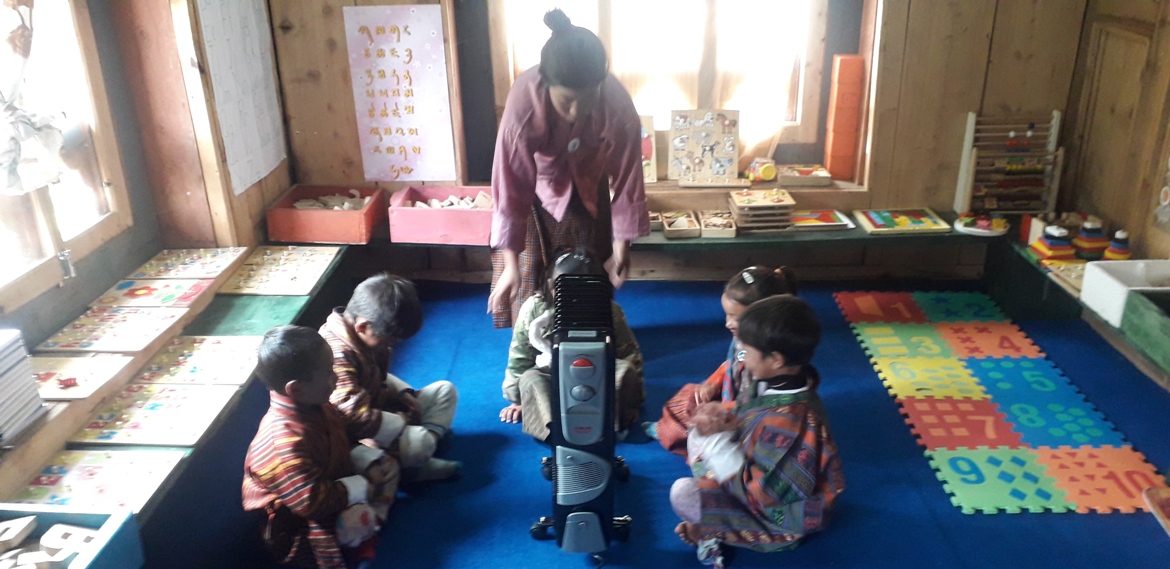
Lungo Extended Classroom (ECR) is one of the most remote and northernmost schools located at an elevation of more than 4000 meters above sea level; high up in the Himalayas in Gasa dzongkhag. Laya Central School is the parent school of the ECR. The school benefited the localities of Lungo Chiwog over the years.
Currently, 24 students are studying under Lungo ECR with two teachers and three Early Childhood Care & Development (ECCD) facilitators. The school remains closed for almost four months in a year because of the short summer and long winter season.
The government of Bhutan fully funded the ECR; thus, providing free education to the children of Lungo. However, the ECR was not equipped with necessities for years.
With help from UNICEF, they could set up a safe playground for the ECCD students and brought toys for the class in 2018; the heating system in the classroom for the children remained as one of the significant challenges.
Due to its unfavourable geographical location and weather, at Lungo ECR, the temperature during the peak summer season climbs hardly above 10 degree Celsius. The students have to carry their pack lunch, and during lunchtime, one can see students taking cold packed lunch, which was prepared early in the morning by their parents back home.
It’s a problem faced by every student studying in the ECR, and also a major challenge for the kids enrolled in ECCD (children from the age of 3-5) without a proper heating system in the classroom, making it difficult for both children and the facilitator to run the centre.
Thus, to overcome these challenges, we wrote a letter to Shama Foundation seeking support to purchase micro-oven that can be used for heating pack lunch and a panel heater for the ECCD classroom.
Shama Foundation is a Non-profit Organisation dedicated to the cause of social welfare, education, and health care. The foundation has benefited the needy societies in Bhutan with an immediate response.
As per our request, Shama Foundation provided financial support to purchase two Panel Heaters and a Microwave oven for the ECCD centre in July 2019. We bought the items from Thinley Norbu Enterprise, Olakha, Thimphu and delivered to Gasa. However, the parcel was stranded in Gasa for weeks due to heavy monsoon that made mule tracks unsafe for travel.
In the last week of August 2019, with the help of Lungo Tshogpa, panel heaters and oven could finally make its way to Lungo ECR. When we see small kids with cute happy smiles worn on their faces enjoying the warm atmosphere of the classroom; it does not doubt bringing happiness in the hearts of people who are involved in making this miracle happen.
We are very much obliged to the founder of Shama Foundation, Mr Surya and his wife, the representative of Shama Foundation in Bhutan, Ms Dorji Wangmo and Lungo Tshogpa for helping us with the transportation.
I am overwhelmed in all humbleness and gratefulness to acknowledge with my sincere appreciation to all those who were involved in making this project happen in Lungo Extended Classroom in Laya, Gasa.
Writing a Research Proposal
- September 5th, 2018
- 3,178 views

The main purpose of a research proposal is to tell others that you have a worthwhile project to conduct and possess the necessary competence to carry it out. In other words, you have to tell people what you plan to do, why you want to do it, and how you are going to do it. You need to convince your reader that you have an exciting research idea and that you have a good grasp of the relevant literature, the major issues involved, and the appropriate methodologies. A good proposal need not be long. Typically, a research proposal comes in two forms,
- A short proposal – a short paragraph to identify the project
- A long proposal – a formal, multiple page-report that provides background information, your rationale for conducting the study, a review of literature, methods, and conclusions. This type of a proposal runs anywhere between 20 to 40 double-spaced pages.
The Short Proposal
This identifies the following,
- The specific topic
- The preliminary thesis sentence or opening hypothesis (research need), intended audience (general or specialized)
- The purpose of the proposed work (explain, analyze and argue)
- The outcome and the constraints
The Long Proposal
Cover Page:
This is optional depending on the length of the report. This should include the title, your name, and the person or agency to whom you are submitting the proposal. Also, the date of submission has to be clearly stated.
Title:
It should be concise and descriptive. For example, the phrase, “An investigation of . . .” could be omitted. Try to make the title catchy; a good title not only pricks the reader’s interest, but also predisposes him/her favourably towards the proposal.
Abstract:
It is a brief summary of approximately 300 words. It should include the research question, the rationale for the study, the hypothesis (if any), and the method. Descriptions of the method should include the design, procedures, the sample, and any instruments that will be used.
Introduction:
The main purpose of the introduction is to define the context and boundaries of your proposed research. Therefore, it will begin with a general statement of the problem area and conclude with a specific research question (purpose statement). You need to explain why you are interested in selecting a particular topic. The introduction should cover the following elements:
- A general statement or description of the research problem, which could be an empirical or theoretical issue. It could also be a technical or non-technical problem. The best approach is to ask a single, important question that can be answered through the proposed research.
- The background of the problem. It should set the stage or provide the context of the research problem. It should provide both the historical background and the contemporary scene, encompassing all the key players and their major publications. In other words, it should paint the research question in broad brushes and cite representative studies.
- A brief description of the major theoretical models related to the research problem, indicating the theoretical perspective you have chosen or developed for your study.
- Identification of the key independent and dependent variables.
- A clear statement of the purpose and rationale of your research, indicating why the study is worth doing.
- A statement of hypotheses and an explanation for your predictions. However, for exploratory or experiential types of research, you may not have any hypotheses.
Literature Review:
This is optional. This may be incorporated within the introduction if the report is not very long and descriptive. This section provides a more detailed and critical review of the literature directly bearing on the proposed research. For example, you should evaluate various theories in the light of available research findings. You should also examine the relevant literature related to the key variables, research instruments. Your scholarship will be in question if you fail to cite some of the influential studies or misread the papers you have cited.
Try to use sub-headings to organize your literature review in a logical and meaningful way. For example, having established the importance of your research area and its current state of development, you may devote several subsections to such issues as: theoretical models, measuring instruments, gender differences, etc. Each subsection should represent a major aspect of your proposed research. For each segment, you need to critically examine relevant literature. The purpose of the literature review is to demonstrate your knowledge and understanding of the problem area, as well as justify your study. You need to convince your reader that your proposed research will make a significant and substantial contribution to the field (i.e. resolve an important theoretical issue or fill a gap in the literature).
Methods:
- Describes the design of the proposed study.
- Describes your population and sampling procedure.
- Describes the measuring instrument to be used.
- Describes the procedure and the time frame of data collection.
- Describes how you will analyze the data.
You need to demonstrate your knowledge of alternative methods and make the case that your approach is most appropriate for your research question. You also need to explain why you choose a particular sample of subjects.
Please note that your research question may be best answered by qualitative research. Since there are no well-established canons in qualitative analysis, your method section needs to be more elaborate than what is required for traditional quantitative research.
Discussion:
States both the significance and limitations of the proposed research. You need to communicate a sense of enthusiasm without exaggerating the merits of your proposal.
Common Mistakes in Proposal Writing
- Failure to provide the proper context to frame the research question.
- Failure to delimit the boundary conditions for your research.
- Failure to cite landmark studies.
- Failure to accurately present the theoretical and empirical contributions by other researchers.
- Failure to stay focused on the research question.
- Failure to develop a coherent and persuasive argument for the proposed research.
- Too much detail on minor issues, but not enough detail on the essentials.
- The proposal is not well-organized. For example, some materials are mentioned two or three times in different sections of the proposal. The most common organizational weakness is that the proposal goes “all over the map” without a clear sense of direction. The best proposals move forward with ease and grace like a seamless river.
- The writing is neither clear nor concise.
Legal Protection of Indigents, a Constitutional Mandate
- June 29th, 2018
- 3,710 views

“A just society is the one where justice prevails throughout alike. To have equal right to approach the court is rendered useless if the right can’t be exercised. It is then, nothing more than a paper promise. The rich and influential can approach the courts because they have means, but the poor have to face injustice simply because they have no money to hire a lawyer. It is therefore in the interest of justice to establish a social order when the poor not only have the right but also the means to seek justice. The idea of legal aid to the poor is, thus a step in this direction”.
Monish Arora, Short Essays & Paragraphs on Law (University Law Publishing Co., Delhi, 2nd Ed., 2006) 75
What do you all think about the legal aid services? I rose to speak, for my heart cried as I effortlessly connected my past and present to the concern that can potentially bring voices to the voiceless should there be this so-called ‘legal aid service’. Displeasing at times, for many of us are barely aware of who an indigent person is. Well, we would have known this noblest idea had it not been cocooned by institutions that can potentially give life to the Council’s proposal.
Well, according to the legislative committee of the NC, an indigent person is a person who is poor, helpless and needy who cannot afford the services of a lawyer for the conduct of a case or a legal proceeding.
In 2014, the then Member of Parliament, Gasa Dzongkhag, Dasho Sangay Khandu, first raised the Legal aid service to an indigent person in Parliament. Following this, the need for providing legal aid services to indigent persons have been discussed in different sessions of the National Council, particularly during the deliberations on the annual budget and appropriation bill. This was because a small amount of budget for this purpose was allocated every year but had never been utilized. Further, the concern was debated during the amendment of the Jabmi Act 2016. A new clause related to the provision of Legal aid was incorporated with the intent of assuring such services to the needy people. The National Council, during its strategic workshop held in Paro from June 25-26, 2017, once again deliberated it weighing in the merit of the concern and decided to undertake a comprehensive review. The Legislative Committee (LC) was assigned the task of conducting the analysis and reporting its findings and recommendation to the House.
The Legislative Committee adopted the following methodology;
- Review of relevant laws and literature
- Consultative meetings with relevant stakeholders
- Learning visit to two countries in Asia
The Legislative Committee (LC) continued its third consultative meeting on the “Policy Review of Legal Aid to Indigent Person” with the Drangpons (Judges) from the Bhutan National Legal Institute (BNLI).
The Drangpons from BNLI shared that though the State provides an annual budget for legal aid. That different laws have different provisions under legal aid, and no agency has been identified/authorized by any of the existing legislation with the responsibility for implementing the provisions on Legal aid. There are no procedural guidelines for availing legal aid. Furthermore, people are unaware of the existence of such legal aid services provided by the State. They pointed out that the main aim of such provision is to provide access to justice; however, an appropriate agency to lead such crucial services could not be identified. One of the highlights of the meeting was the need for a clear definition as to who should qualify as an indigent person and who is eligible to receive such a legal aid.
Deliberations were held with regard to the possibility of creating a small interim cell mandated to evaluate the provisions of legal aid to indigent persons within the jurisdictions of Judiciary (such as Supreme Court) or whether the Bar Council would be the appropriate agency to provide legal aid instead of the establishment of a separate agency. It was found that Bar Council had a mandate of providing pro bono services to indigent persons but did not have the mandate to spearhead the legal aid services.
The National Council (NC) members with a show of hands endorsed all the provisions of the final resolutions on legal aid services and legal aid to an indigent person on November 28, 2017. The resolution has been forwarded to the Government in the hope of endorsement.
The crux of resolution was that the existing institutions such as the Office of Attorney General (OAG), Judiciary, Bhutan National Legal Institute (BNLI), the National Commission for Women and Children (NCWC) and Bar Council do not seem appropriate to initiate such legal aid in the country due to conflicts of interest and differing mandates.
Moreover, pertaining to civil matters, due caution should be exercised right from the beginning to prioritize the nature of cases such as those concerning family (matrimonial), children, domestic violence, monetary matters, land or property issues and issues arising from the infringement of constitutional rights to provide legal aid to indigent persons.
“The legal aid services and legal aid to an indigent person are available from the time the accused is held in custody to facilitate sufficient means to fairer judicial determinations,” the resolution stated.
The legal aid to an indigent person according to the resolution, should be eligible to persons with an income of Nu. 39,000 in a year based on the national minimum wage of Nu. 125 per day (Nu. 3,250 per month), or Nu. 69,648 in a year for urban areas and Nu. 39,012 in a year for rural areas based on the mean monthly per capita household expenditure of 2012.
Furthermore, it also mandates educational and awareness programme to raise awareness of the importance and availability of legal aid services to the general public and in particular, among police, courts and community functionaries.
Should indigent proposal come through and the Government of the day embraces the pros over insignificant cons in adopting the noblest idea, I’m in total agreement with some of the concerns raised by the then MPs that the legal aid service outlets should be only accessible to only the needy and voiceless – so-called ‘kha-med chey-med’. And yes, this should not open a floodgate for state fund. Stringent criteria must be adopted, and common ground must be found.
Marking a set back to the Council’s proposal, recently the Government has responded positively to the 20th Session’s resolution on providing legal aid to indigent persons. In fact, the response from the Government came lately towards the end of the 21st Session after the Council’s re-deliberation on the Government’s lack of response to its resolution. Nonetheless, the election of the National Assembly is around the corner and we hope the upcoming Government will continue to implement the resolution as stated in the response letter dated 25/06/2018. By doing so, it will uphold the Constitutional clauses that states, “The State shall endeavour to provide legal aid to secure justice, which shall not be denied to any person by reason of economic or other disabilities” and “All persons are equal before the law and are entitled to equal and effective protection of the law and shall not be discriminated against on the grounds of race, sex, language, religion, politics or other status”.
“The State shall endeavour to provide legal aid to secure justice, which shall not be denied to any person by reason of economic or other disabilities”
“All persons are equal before the law and are entitled to equal and effective protection of the law and shall not be discriminated against on the grounds of race, sex, language, religion, politics or other status”
Disclaimer: The views expressed in here are self-authored based on existing literature and do not necessarily reflect the national council’s stance.
Browse Category
- Gasa Issues (11)
- National Issues (14)
- Personal (3)
- Perspectives (7)
- Speeches (2)




